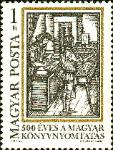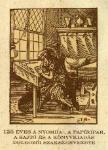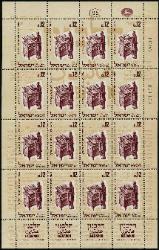| 8c--Type Composition |
Compositors and their type cases have been used to represent printing anniversaries, to remind viewers that individuals
being honored were, at least sometimes, compositors, and as symbols of shops where hand-printing was done. The
compositor was the person “whose business is to set up type to print from” according to the earliest known definition,
first published in 1569. In a hand-printing shop, type is stored in shallow trays, each containing one font—a complete
assortment of capitals, small capitals, lower-case letters, numerals, and punctuation marks. The tray (or “case”) is
divided into small rectangular sections, each containing multiples of a single character. At one time, two cases were used,
the lower one, closest to the compositor’s hand, contained small letters (thus, “lower-case letters”), and the one mounted
above it and farther from the compositor (because it was accessed less often), the capital (or “upper-case”) letters.
Standing in front of a case, the compositor selected each character and slid it into a composing stick he held in his left
hand. He added leads and quads to fill out the line as needed. When the line was set, he proofed it for errors, and then
moved it to a galley. The compositor then began the next line, and so on. The first compositors in the 15th century may
have been unemployed scribes rendered redundant by the new printing technology. Contests among compositors were
popular in the 19th century. Just prior to the invention of a typesetting machine, high-speed compositors were called
“swifts” in newspaper print shops, and their competitions were legendary. [Excerpted from “Compositors on Stamps,” by
Martha Jane Zachert, in Philateli-Graphics, Vol. 13, No. 2 (April 1991), pages 11, 15-16].
being honored were, at least sometimes, compositors, and as symbols of shops where hand-printing was done. The
compositor was the person “whose business is to set up type to print from” according to the earliest known definition,
first published in 1569. In a hand-printing shop, type is stored in shallow trays, each containing one font—a complete
assortment of capitals, small capitals, lower-case letters, numerals, and punctuation marks. The tray (or “case”) is
divided into small rectangular sections, each containing multiples of a single character. At one time, two cases were used,
the lower one, closest to the compositor’s hand, contained small letters (thus, “lower-case letters”), and the one mounted
above it and farther from the compositor (because it was accessed less often), the capital (or “upper-case”) letters.
Standing in front of a case, the compositor selected each character and slid it into a composing stick he held in his left
hand. He added leads and quads to fill out the line as needed. When the line was set, he proofed it for errors, and then
moved it to a galley. The compositor then began the next line, and so on. The first compositors in the 15th century may
have been unemployed scribes rendered redundant by the new printing technology. Contests among compositors were
popular in the 19th century. Just prior to the invention of a typesetting machine, high-speed compositors were called
“swifts” in newspaper print shops, and their competitions were legendary. [Excerpted from “Compositors on Stamps,” by
Martha Jane Zachert, in Philateli-Graphics, Vol. 13, No. 2 (April 1991), pages 11, 15-16].
- Please CLICK on an image for an ENLARGED version.
A two-value set commemorating
“Discoveries” includes this 60-
pfennig value honoring the
“printing press by Johannes
Guttenburg”[sic]. The stamp
actually depicts a piece of type
with Gutenberg’s type specimen
sheet as background as shown
on this FDC (Germany, Scott #
1392).
“Discoveries” includes this 60-
pfennig value honoring the
“printing press by Johannes
Guttenburg”[sic]. The stamp
actually depicts a piece of type
with Gutenberg’s type specimen
sheet as background as shown
on this FDC (Germany, Scott #
1392).
Both Bulgaria and the German
Democratic Republic have honored
men well-known for their influential
Communistic writing by showing them
as compositors. On 8 May 1972,
Bulgaria commemorated the 90th
anniversary of the birth of George
Dimitrov by showing him, manuscript
in hand, standing in front of a typecase
setting type (Bulgaria, Scott #2023). On
16 April 1970, the German Democratic
Republic showed Lenin in front of a
typecase, hinting at his personal use
of it in printing his newspaper Iskra
(German Democratic Republic, Scott
#1188).
Democratic Republic have honored
men well-known for their influential
Communistic writing by showing them
as compositors. On 8 May 1972,
Bulgaria commemorated the 90th
anniversary of the birth of George
Dimitrov by showing him, manuscript
in hand, standing in front of a typecase
setting type (Bulgaria, Scott #2023). On
16 April 1970, the German Democratic
Republic showed Lenin in front of a
typecase, hinting at his personal use
of it in printing his newspaper Iskra
(German Democratic Republic, Scott
#1188).
The stamp on this interesting FDC was issued on 9 April
1991 to commemorate the 125th anniversary of Lette-Verein
(the “Lette Association”).The history of the Lette Association
(now “Foundation”) is closely linked to the city of Berlin. The
Prussian legislator Wilhelm Adolf Lette started an
“organization to promote professional careers for women” on
27 February 1866. By 1890, the organization offered
vocational education in its seven schools and until 1910 was
exclusively for women. A new school building at Berlin’s
Viktoria-Luise Square by architect Alfred Messel opened in
1902, and the organization became a public foundation in
1943. The Lette Foundation responded to the demands of a
constantly changing society and work conditions with
innovative and practical educational possibilities, one of
which was training women to compose type. The stamp and
the cache in this FDC, therefore, depict women standing at
type cases and setting type (Germany, Scott #1637).
1991 to commemorate the 125th anniversary of Lette-Verein
(the “Lette Association”).The history of the Lette Association
(now “Foundation”) is closely linked to the city of Berlin. The
Prussian legislator Wilhelm Adolf Lette started an
“organization to promote professional careers for women” on
27 February 1866. By 1890, the organization offered
vocational education in its seven schools and until 1910 was
exclusively for women. A new school building at Berlin’s
Viktoria-Luise Square by architect Alfred Messel opened in
1902, and the organization became a public foundation in
1943. The Lette Foundation responded to the demands of a
constantly changing society and work conditions with
innovative and practical educational possibilities, one of
which was training women to compose type. The stamp and
the cache in this FDC, therefore, depict women standing at
type cases and setting type (Germany, Scott #1637).
Setting type by hand was eventually
replaced by mechanical typesetting.
The Mergenthaler Linotype typesetting
machine was put on the market in
1884. The centennial of Ottmar
Mergenthaler’s birthday (1854-1899)
was commemorated on 11 May 1954 by
a 10-pfennig stamp depicting
Mergenthaler and his Linotype.
(Germany—Berlin, Scott #9N105). The
“Merg,” in turn, has been superceded
by cold type, computerized typesetting,
and desktop publishing, as
represented by a stamp from Great
Britain, issued on 8 September 1982 to
commemorate “Information
Technology”; the 15½pence value
includes a depiction of word processing
(Great Britain, Scott #1000).
replaced by mechanical typesetting.
The Mergenthaler Linotype typesetting
machine was put on the market in
1884. The centennial of Ottmar
Mergenthaler’s birthday (1854-1899)
was commemorated on 11 May 1954 by
a 10-pfennig stamp depicting
Mergenthaler and his Linotype.
(Germany—Berlin, Scott #9N105). The
“Merg,” in turn, has been superceded
by cold type, computerized typesetting,
and desktop publishing, as
represented by a stamp from Great
Britain, issued on 8 September 1982 to
commemorate “Information
Technology”; the 15½pence value
includes a depiction of word processing
(Great Britain, Scott #1000).
Hungary commemorated the
500th anniversary of book
printing in Hungary (Chronica
Hungarorum in 1473) with a pair
of stamps. The 1-forint stamp
depicts a compositor at work, a
woodcut taken from Orbis
Pictus by Comenius (Jan Amós
Komensky), printed in
Nuremberg in the 1650s, one of
the world's first illustrated
textbooks for teaching young
children (Hungary, Scott 2229).
500th anniversary of book
printing in Hungary (Chronica
Hungarorum in 1473) with a pair
of stamps. The 1-forint stamp
depicts a compositor at work, a
woodcut taken from Orbis
Pictus by Comenius (Jan Amós
Komensky), printed in
Nuremberg in the 1650s, one of
the world's first illustrated
textbooks for teaching young
children (Hungary, Scott 2229).
The 125th anniversary of the
Hungarian Printing, Paper, and
Press Workers’ Union was
commemorated on 25 June 1987
with this remarkable stamp
based upon an 17th-century
woodcut by Abraham von Werdt.
The engraving is of the interior
of a printing shop that depicts
the tools of the printing art in
the Netherlands, a center of the
publishing trade. The engraving
was first used as an illustration
in Orbis Pictus by Comenius in
1658 (Hungary, Scott #3074).
Hungarian Printing, Paper, and
Press Workers’ Union was
commemorated on 25 June 1987
with this remarkable stamp
based upon an 17th-century
woodcut by Abraham von Werdt.
The engraving is of the interior
of a printing shop that depicts
the tools of the printing art in
the Netherlands, a center of the
publishing trade. The engraving
was first used as an illustration
in Orbis Pictus by Comenius in
1658 (Hungary, Scott #3074).
Ireland commemorated the
centennial of the Dublin Council of
Trade Unions on 21 August 1986 with
this 24-pence stamp depicting one of
Mergenthaler’s Linotypes (Ireland,
Scott #669).
centennial of the Dublin Council of
Trade Unions on 21 August 1986 with
this 24-pence stamp depicting one of
Mergenthaler’s Linotypes (Ireland,
Scott #669).
This extraordinary souvenir
sheet from Israel was issued on
19 June 1963 to commemorate
the centennial of the Hebrew
press in Palestine. Issued in
sheets of 16, each stamp depicts
a 19th century compositor at
work, but the background of the
entire sheet shows one page
from the first issue (1863) of
Halbanon newspaper, thereby
giving each stamp a different
background (Israel, Scott #241).
sheet from Israel was issued on
19 June 1963 to commemorate
the centennial of the Hebrew
press in Palestine. Issued in
sheets of 16, each stamp depicts
a 19th century compositor at
work, but the background of the
entire sheet shows one page
from the first issue (1863) of
Halbanon newspaper, thereby
giving each stamp a different
background (Israel, Scott #241).
The first stamp in this two-value set
issued on 11 December 1987 that
commemorates the 175th
anniversary of the Curaçao Courant
shows a job press featuring a
close-up of a type case loaded with
lead type (Netherlands Antilles,
Scott #589).
issued on 11 December 1987 that
commemorates the 175th
anniversary of the Curaçao Courant
shows a job press featuring a
close-up of a type case loaded with
lead type (Netherlands Antilles,
Scott #589).
Two pieces of type are featured on
this 55-cent value and label from
the Netherlands issued to
commemorate the 500th anniversary
of the Delft Bible, the oldest book
printed in Dutch. The stamp was
produced in sheets of 50 se-tenant
with a label that described the
stamp design and its purpose
(Netherlands, Scott #568).
this 55-cent value and label from
the Netherlands issued to
commemorate the 500th anniversary
of the Delft Bible, the oldest book
printed in Dutch. The stamp was
produced in sheets of 50 se-tenant
with a label that described the
stamp design and its purpose
(Netherlands, Scott #568).











